P-51D Cripes a Mighty 3rd June 1944
This article is part of a series:
This is the 1/32 scale Tamiya P-51D built to resemble Preddy's aircraft in late June of 1944. The aircraft had full invasion stripes around the wings and fuselage. I used Eagle Editions EagleCals set EC#100 for the markings and they were excellent. The instrument panel was an Eduard Look set and the seat belts were also applied from that set and superior to the kit supplied belts. I also used Barracuda cast wheels, the rubber set provided looked awful.
Much of the rest of the cockpit was from Barracuda cast to include the cockpit walls, the radio pack, many of the decals and other details. The black rails that guided the canopy and other photoetched details from that set were also used.
I prefer the looks of the early Mustangs without the fin fillet. The aircraft just looks smoother, although I have never seen a restored mustang with the early configuration.
The wings were primed with Stynylrez gray primer, then Testors yellow zinc chromate was used to simulate the primer color when painted in the factory. Classic Floquil Old Silver was the final coat to differentiate the wings from the fuselage and other parts of the aircraft that were left in the original metal color. I did not attempt to make the rivets and seams between the wing panels invisible--because I like the look as is, especially with the weathering. The invasion strips were masked off and then painted on, first the white and then the black. It can be seen that the strips varied in width and were not particularly straight (see period photo).
Enough of the engine was assembled and placed on the mounts to provide structure for the nose panels. I generally do not like uncowled engines--as a pilot it looks like something is wrong and expensive. That was the only area where fit seemed to be an issue. The assembled fuselage was primed in Tamiya semi-gloss black and several shades of Alclad metallizers used . The rudder is again Old Silver. The invasion stripes were based on photos. I used stencils cut from a photocopy of the EagleCals insignia to provide a mask to ensure that the invasion stripes did not interfere with the application of the decals. The Bodney blue of this time was the lighter blue and the formula provided in the Tamiya instructions looks accurate. I used a clearcoat over the entire aircraft, applied decals, and then used a light application of Testors dullcoat to cut the gloss.
Weathering was done using oils, pastels, and airbrushing the exhaust stains. I used some artistic license to highlight some aspects of the aircraft a bit. Dullcoat was used to protect some of the pastels. The only issue with finishing is that after a year since I built the plane there are very tiny cracks in some of the finish.
My only--but major--issue with the kit were all of the movable parts and build options that took too much time. I ended up not using any of these and glued everything in place. If I were to build another one I would just decide on a version and start to it. The molding and presentation of the parts was excellent.
As many of you know, Major George Preddy was killed by friendly fire on December 25, 1944. The incident is well covered in the EagleCals direction booklet. My next Mustang will be the 1/48th Eduard early model D kit.
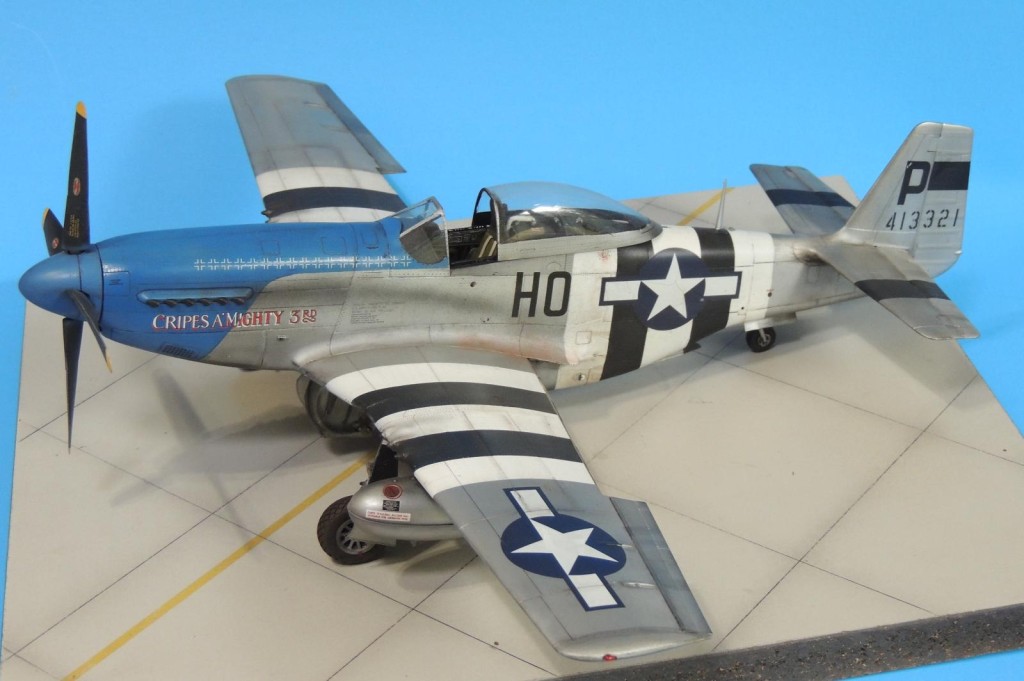
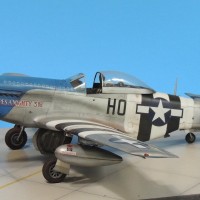
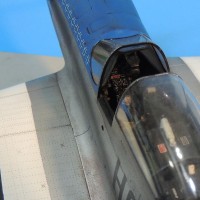
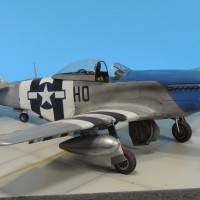
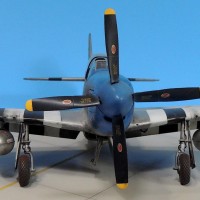
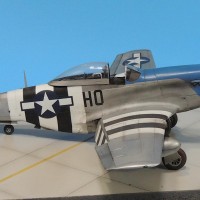
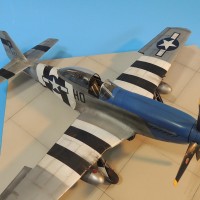
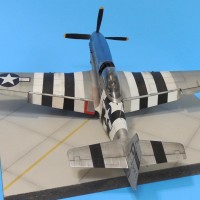
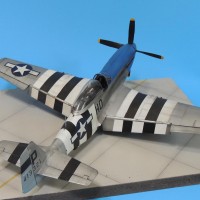
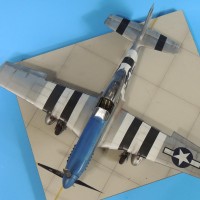
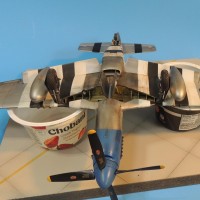
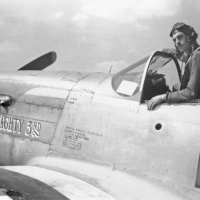


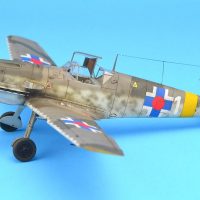
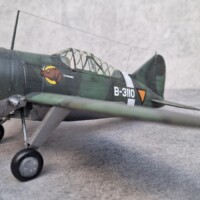
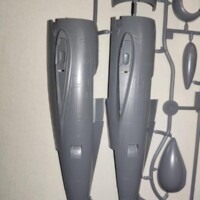
Stunning looking Mustang Wayne! Great weathering overall.
Thanks Triet! Mustangs are a good canvas to work from.
That looks brilliant! Clean and businesslike. I agonise over the cowls off/on debate. I love the engines. For me it's at least half the story of these incredible machines. However, clean lines like this... You're right though. Decide and stick with it!
One question. If you wanted a "clean" cowled non fillet Mustang why not the much cheaper and in my view excellent Revell (Eduard cockpit upgrade of course)?
Ross--I have one of the Revell Mustangs and I bought it after this one was almost done. A friend of mine has put one together and they are a lot more work to get to fit correctly. The non-fillet tail was part of the Tamiya kit anyway. I bought the Tamiya kit not too long after they came out so I had it in the stash already.
I also noted that Barracuda casts has an update kit for the Revell kit as well. I will try that kit next and I have several Eagle editions decal options for early model P-51Ds.
Thanks for the note.
Amazing result, Wayne @spotlandis
Always great to see this blue nosed scheme.
John
The Blue Nosed Bastards of Bodeny have been one of my favorite squadrons since early days. Thanks for the note!
Congratulations Wayne!
A superb Mustang!
Thanks Spiros--it's time for another mustang.
Really nice result with this. I particularly like what you did with the invasion stripes and the detail about the overspray on the spinner. That's good research.
The P-51D-5 does "look cool," but I can assure you that every wartime P-51 pilot I ever spoke to loved that dorsal fin. There's a reason why every one of the P-51D-5s were changed as soon as the field modification kits were available. Note also the number of B/C P-51s that had a dorsal fin added. When Edgar Schmued spoke at the 40th anniversary presentation on the Mustang out at Planes of Fame, he said the one mistake he made in the initial design was the lack of sufficient directional stability.
Thanks for the note Tom. Clearly the P-51D had stability issues in yaw. The implementation of the bubble top took away vertical surface area behind the CG so the rest is just math. Did Schmued say that was true for the early models with perhaps less power and perhaps a more forward CG? Clearly the D-5s were very successful aircraft. I note that yaw stability continued to be an issue--hence the P-51Hs had a dorsal fin and an even taller vertical fin-rudder assembly.
The Allison ponies were pretty much considered the best flyers by everyone who flew one and then the later versions. Lightweight with the best power-to-weight, they just weren't much good above 25,000 feet.
Tom, I have read the several pilot evaluations and agree. The Allison Mustangs were outstanding low-altitude aircraft. I have built the Accurate Miniatures series P-51s and A-36. I think there is only one flyable Allison Mustang (A-36) still in existence. Thanks for the conversation.
Looks great, Wayne. Fine job.
Gary--thanks for the note. It was a fun build even though it took a long time.
Nice looking Pony Wayne, blue nose Mustangs always look good to me.
Tom--absolutely.
Excellent Pony! I've always love the blue-nosed 51's. Paint and weathering or perfect to me!
Greg--thanks for the note. I really enjoy painting and weathering in 1/32 scale. Even subtle pastels and painting small details show up in the photos.
Exceptional work, Wayne, thanks for sharing your experience and knowledge !
Chris-thanks for the note. I enjoy the combination of history, engineering and art that modeling provides.
Ciao, great job ! I’m working at the same airplane by Hasegawa in 1/48 but the blue is too dark, can I ask you which color you used for the blue nose? Thanks
I used the mix of Tamiya paints listed in the Tamiya directions. You can find the directions online and I used the color for Petie 2nd. The mixture is Tamiya paint X-14 :3 parts and XF-8 :1 part. To measure the ratio I used a typical graduate small medicine cup. I think it matches very well.